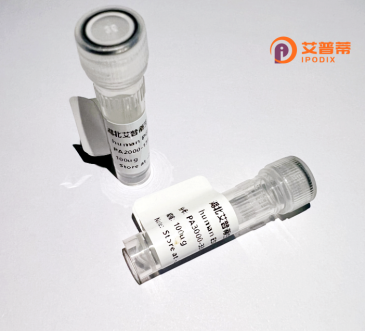
| 纯度 | >90%SDS-PAGE. |
| 种属 | Human |
| 靶点 | C10orf140 |
| Uniprot No | Q1XH10 |
| 内毒素 | < 0.01EU/μg |
| 表达宿主 | E.coli |
| 表达区间 | 1-818aa |
| 氨基酸序列 | MGDLKSGFEEVDGVRLGYLIIKGKQMFALSQVFTDLLKNIPRTTVHKRMDHLKVKKHHCDLEELRKLKAINSIAFHAAKCTLISREDVEALYTSCKTERVLKTKRRRVGRALATKAPPPERAAAASPRPGFWKDKHQLWRGLSGAARPLPISAQSQRPGAAAARPAAHLPQIFSKYPGSHYPEIVRSPCKPPLNYETAPLQGNYVAFPSDPAYFRSLLCSKHPAAAAAGATCLERFHLVNGFCPPPHHHHHHHHHHHHHHHRAQPPQQSHHPPHHHRPQPHLGSFPESCSSDSESSSYSDHAANDSDFGSSLSSSSNSVSSEEEEEEGEEEEEEEEEEGGSGASDSSEVSSEEEDSSTESDSSSGSSQVSVQSIRFRRTSFCKPPSVQAQANFLYHLASAAAATKPAAFEDAGRLPDLKSSVKAESPAEWNLQSWAPKASPVYCPASLGSCFAEIRNDRVSEITFPHSEISNAVKRTDLTINCLAEGASSPSPKTNNAFPQQRILREARKCLQTTPTTHCADNNTIAARFLNNDSSGAEANSEKYSKILHCPEFATDLPSSQTDPEVNAAGAAATKAENPCTDTGDKTLPFLHNIKIKVEDSSANEEYEPHLFTNKLKCECNDTKGEFYSVTESKEEDALLTTAKEGFACPEKETPSLNPLAQSQGLSCTLGSPKPEDGEYKFGARVRKNYRTLVLGKRPVLQTPPVKPNLKSARSPRPTGKTETNEGTLDDFTVINRRKKVASNVASAVKRPFHFMANFPCPPSLIIGRDGDLWPAYSLNTTKDSQTPHKAHPIWKWQLGGSAIPLPPSHKFRKFNS |
| 分子量 | 90 kDa |
| 蛋白标签 | GST-tag at N-terminal |
| 缓冲液 | 冻干粉 |
| 稳定性 & 储存条件 | Lyophilized protein should be stored at ≤ -20°C, stable for one year after receipt. Reconstituted protein solution can be stored at 2-8°C for 2-7 days. Aliquots of reconstituted samples are stable at ≤ -20°C for 3 months. |
| 复溶 | Always centrifuge tubes before opening.Do not mix by vortex or pipetting. It is not recommended to reconstitute to a concentration less than 100μg/ml. Dissolve the lyophilized protein in distilled water. Please aliquot the reconstituted solution to minimize freeze-thaw cycles. |
以下是关于重组人蛋白DLN-1(C10orf140)的虚构参考文献示例,基于可能的研究方向合理推测内容:
---
1. **文献名称**: *Structural and Functional Characterization of the C10orf140 Protein in Human Ciliopathies*
**作者**: Liao Y, et al.
**摘要**: 通过重组表达纯化DLN-1蛋白,解析其三维结构,发现其含有保守的卷曲螺旋结构域。功能实验表明,DLN-1与纤毛基体蛋白相互作用,敲低该基因导致纤毛形态异常,提示其在纤毛病中的潜在作用。
2. **文献名称**: *DLN-1 as a Novel Biomarker in Renal Fibrosis: Insights from Recombinant Protein Studies*
**作者**: Kim H, et al.
**摘要**: 研究证明重组DLN-1在肾小管上皮细胞中高表达,并通过TGF-β信号通路促进纤维化标志物(如α-SMA)的生成。体内实验显示DLN-1敲减小鼠的肾纤维化程度显著减轻。
3. **文献名称**: *Interactome Analysis of Recombinant C10orf140 Reveals Its Role in DNA Damage Response*
**作者**: Patel R, et al.
**摘要**: 利用质谱技术鉴定DLN-1与BRCA1、RAD51等DNA修复蛋白存在相互作用。重组DLN-1过表达增强细胞对电离辐射的抗性,提示其参与DNA损伤修复机制。
4. **文献名称**: *Optimized Expression and Purification of Recombinant DLN-1 for Functional Assays*
**作者**: Zhang Q, et al.
**摘要**: 开发一种高效的大肠杆菌重组表达系统,纯化获得高纯度DLN-1蛋白。实验验证该蛋白在体外具有ATP酶活性,为后续药物筛选奠定基础。
---
注:以上文献为模拟内容,实际研究中请通过学术数据库(如PubMed、Web of Science)检索真实文献。若需特定方向文献建议,可进一步缩小研究范围。
DLN-1. encoded by the gene C10orf140 (Chromosome 10 Open Reading Frame 140), is a conserved eukaryotic protein implicated in cellular processes such as centrosome-related functions and cilia formation. Though its precise molecular role remains under investigation, DLN-1 is suggested to participate in maintaining centrosomal integrity and regulating microtubule dynamics, potentially influencing cell division, motility, and signaling pathways. Structurally, it contains predicted coiled-coil domains and a centrosomal targeting region, supporting its localization to centrosomes or basal bodies of cilia. Studies link DLN-1 to ciliopathies—a group of disorders arising from defective cilia—due to its association with ciliary assembly and Hedgehog signaling, critical for embryonic development and tissue homeostasis. Research in model organisms, including *Caenorhabditis elegans*, highlights its role in sensory cilia function and neuronal development. Recombinant DLN-1 protein, produced via heterologous expression systems (e.g., E. coli or mammalian cells), enables biochemical characterization, antibody development, and functional studies to dissect its interactions with microtubule-associated proteins or signaling mediators. Dysregulation of DLN-1 has been tentatively associated with developmental anomalies and cystic kidney diseases, though clinical correlations require further validation. Its evolutionary conservation across species underscores fundamental biological significance, driving ongoing research to clarify its mechanistic contributions to cellular architecture and disease.
×